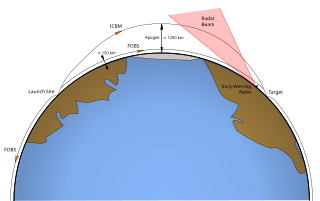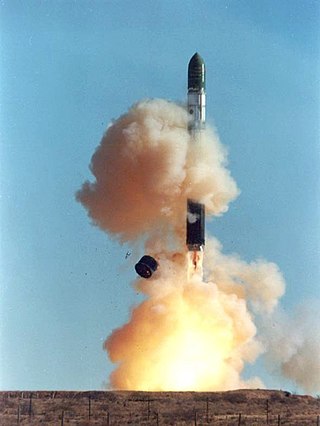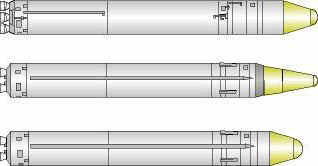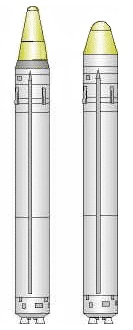
An intercontinental ballistic missile (ICBM) is a ballistic missile with a range greater than 5,500 kilometres (3,400 mi), primarily designed for nuclear weapons delivery. Conventional, chemical, and biological weapons can also be delivered with varying effectiveness, but have never been deployed on ICBMs. Most modern designs support multiple independently targetable reentry vehicle (MIRVs), allowing a single missile to carry several warheads, each of which can strike a different target. The United States, Russia, China, France, India, the United Kingdom, Israel, and North Korea are the only countries known to have operational ICBMs.

Titan was a family of United States expendable rockets used between 1959 and 2005. The Titan I and Titan II were part of the US Air Force's intercontinental ballistic missile (ICBM) fleet until 1987. The space launch vehicle versions contributed the majority of the 368 Titan launches, including all the Project Gemini crewed flights of the mid-1960s. Titan vehicles were also used to lift US military payloads as well as civilian agency reconnaissance satellites and to send interplanetary scientific probes throughout the Solar System.
The SM-65 Atlas was the first operational intercontinental ballistic missile (ICBM) developed by the United States and the first member of the Atlas rocket family. It was built for the U.S. Air Force by the Convair Division of General Dynamics at an assembly plant located in Kearny Mesa, San Diego.

The Strategic Rocket Forces of the Russian Federation or the Strategic Missile Forces of the Russian Federation is a separate-troops branch of the Russian Armed Forces that controls Russia's land-based intercontinental ballistic missiles (ICBMs). It was formerly part of the Soviet Armed Forces from 1959 to 1991.

The R-2 was a Soviet short-range ballistic missile developed from and having twice the range as the R-1 missile. Developed from 1946-1951, the R-2 entered service in numbers in 1953 and was deployed in mobile units throughout the Soviet Union until 1962. A sounding rocket derivative, the R-2A, tested a prototype of the dog-carrying capsule flown on Sputnik 2 in 1957. The same year, the R-2 was licensed for production in The People's Republic of China, where it entered service as the Dongfeng 1.

A Fractional Orbital Bombardment System (FOBS) is a warhead delivery system that uses a low Earth orbit towards its target destination. Just before reaching the target, it deorbits through a retrograde engine burn.

The R-36 is a family of intercontinental ballistic missiles (ICBMs) and space launch vehicles (Tsyklon) designed by the Soviet Union during the Cold War. The original R-36 was deployed under the GRAU index 8K67 and was given the NATO reporting name SS-9 Scarp. It was able to carry three warheads and was the first Soviet MRV missile. The later version, the R-36M, also known as RS20, was produced under the GRAU designations 15A14 and 15A18 and was given the NATO reporting name SS-18 Satan. This missile was viewed by certain United States analysts as giving the Soviet Union first strike advantage over the U.S., particularly because of its rapid silo-reload ability, very heavy throw weight and extremely large number of re-entry vehicles. Some versions of the R-36M were deployed with 10 warheads and up to 40 penetration aids and the missile's high throw-weight made it theoretically capable of carrying more warheads or penetration aids. Contemporary U.S. missiles, such as the Minuteman III, carried up to three warheads at most.

The RT-2PM Topol was a mobile intercontinental ballistic missile designed in the Soviet Union and in service with Russia's Strategic Missile Troops. As of 2014, Russia planned to replace all RT-2PM ICBMs with versions of Topol-M. In December 2023, last Topol regiment was taken off combat duty.

The R-9 was a two-stage IRBM of the Soviet Union, in service from 1964 to 1976.

The R-12 Dvina was a theatre ballistic missile developed and deployed by the Soviet Union during the Cold War. Its GRAU designation was 8K63, and it was given the NATO reporting name of SS-4 Sandal. The R-12 rocket provided the Soviet Union with the capability to attack targets at medium ranges with a megaton-class thermonuclear warhead and constituted the bulk of the Soviet offensive missile threat to Western Europe. Deployments of the R-12 missile in Cuba caused the Cuban Missile Crisis in 1962. A total of 2335 missiles were produced; all were destroyed in 1993 under the START II treaty.
The Global Rocket 1 was a Fractional Orbital Bombardment System (FOBS) intercontinental ballistic missile (ICBM) developed but not deployed by the Soviet Union during the Cold War. The system also was given the NATO reporting name SS-X-10 Scrag, and carried a Soviet GRAU index of 8K713 (8К713).

The UR-100 was an intercontinental ballistic missile (ICBM) developed and deployed by the Soviet Union from 1966 to 1996. UR (УР) in its designation stood for Universal Rocket. It was known during the Cold War by the NATO reporting name SS-11 Sego and internally by the GRAU index 8K84. The Strela and Rokot carrier rockets were based on it.

The UR-100N, also known as RS-18A, is an intercontinental ballistic missile in service with Soviet and Russian Strategic Missile Troops. The missile was given the NATO reporting name SS-19 Stiletto and carries the industry designation 15A30.

Rokot, also transliterated Rockot, was a Soviet Union space launch vehicle that was capable of launching a payload of 1,950 kilograms (4,300 lb) into a 200-kilometre (120 mi) Earth orbit with 63° inclination. It was based on the UR-100N intercontinental ballistic missile (ICBM), supplied and operated by Khrunichev State Research and Production Space Center. The first launches started in the 1990s from Baikonur Cosmodrome out of a silo. Later commercial launches commenced from Plesetsk Cosmodrome using a launch ramp specially rebuilt from one for the Kosmos-3M launch vehicle. The cost of the launcher itself was about US$15 million in 1999; The contract with European Space Agency (ESA) for launching Swarm in September 2013 was worth €27.1 million.

Start-1 is a Russian satellite launch vehicle based on the RT-2PM Topol, a Soviet intercontinental ballistic missile developed by Moscow Institute of Thermal Technology.

Strela is a Russian orbital carrier rocket, derived from the Soviet/Russian UR-100NU missile. It conducted its maiden test launch on 5 December 2003, carried its first functional payload on 27 June 2013, and a second one on 19 December 2014.
The Universal Rocket or UR family of missiles and carrier rockets is a Russian, previously Soviet rocket family. Intended to allow the same technology to be used in all Soviet rockets, the UR is produced by the Khrunichev State Research and Production Space Center. Several variants were originally planned, of which only three flew, and only two of which entered service. In addition, the cancelled UR-500 ICBM formed the basis for the Proton carrier rocket.

The RD-0210 (GRAU Index: 8D411K) is also known as the RD-465. It and its twin, the RD-0211, are rocket engines burning N2O4 and UDMH in an oxidizer rich staged combustion cycle. They have single nozzle, possess TVC and are the latest evolution in the RD-0203/4 lineage. They are the engines used on the Proton second stage. The RD-0213 is a fixed nozzle variation that is used on the RD-0212 module of the Proton third stage.
The RD-861 is a Soviet liquid propellant rocket engine burning UDMH and nitrogen tetroxide in a gas generator combustion cycle. It has a main combustion chamber, with four vernier nozzles fed by the gas generator output. It can be reignited a single time.














